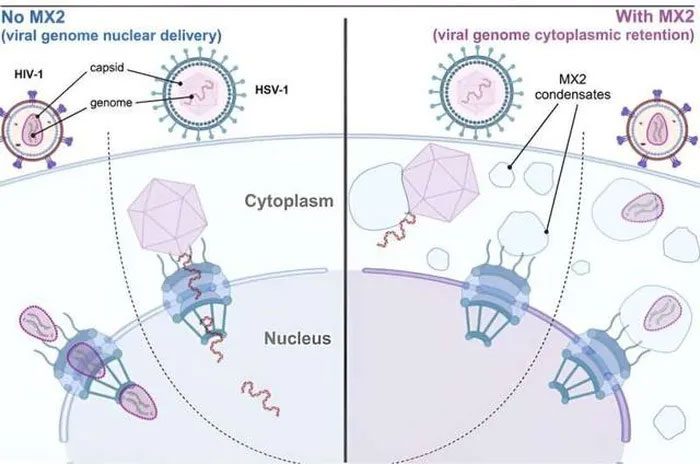A group of researchers has discovered a type of protein that interacts with the human immune system to block HIV-1 and herpes simplex virus-1 by assembling structures within cells to attract these viruses and subsequently trap or even separate them.
This research, led by first author George Moschonas, was published in Cell Host & Microbe and could pave the way for new strategies to combat these viruses. The team was headed by Xavier Saelens and Sven Eyckerman at the VIB-UGent Center for Medical Biotechnology.
The innate immune system of the human body can sense and respond to viruses by producing alarming cytokines, most notably interferons. These proteins act as an alarm system when a cell is infected by a virus, warning surrounding cells of the invasion and prompting them to activate their antiviral defense mechanisms.

Simulation of how MX protein fights viruses.
These defensive measures include interferon-stimulated genes (ISGs), which produce specific proteins with antiviral properties. One such example is the MX protein, discovered 60 years ago, known for its ability to restrict various types of viruses, including those that cause AIDS and herpes.
So far, researchers have not fully understood how the antiviral properties of the MX protein work. However, this new study has uncovered the secrets behind the antiviral actions of the MX protein.
Herpes viruses or HIV insert their genetic material into the host cell nucleus through the nuclear pore complex. This insertion is crucial for the viruses to initiate their genetic program, hijack the cell’s machinery, and replicate. As a result, new viruses are produced, leaving the cell and spreading to surrounding cells.
In a groundbreaking discovery, researchers demonstrated how the MX protein facilitates the assembly of bait structures that mimic nuclear pore complexes.
Researcher Eyckerman stated, “We found that invading viruses are lured into nuclear pore-like structures.” Through proteomics screening, we discovered that the MX protein interacts with proteins that are part of the nuclear pore complex. The MX protein coordinates the assembly of nucleoporins into biomolecular condensates, membrane-less droplets inside cells that function as separate compartments. Viruses mistake these condensates for actual cell entry points, resulting in the virus getting stuck or punctured in the nucleus.
Researcher Saelens added, “By tricking viruses into releasing their genetic material prematurely, the MX protein ultimately prevents the spread of viral infections.” This discovery not only clarifies how the MX protein combats viruses but also opens up potential new avenues for antiviral therapies.


















































